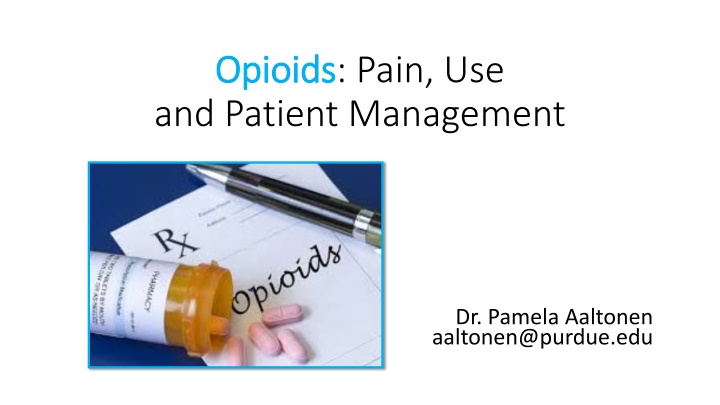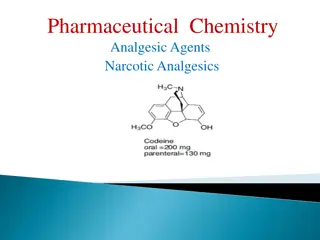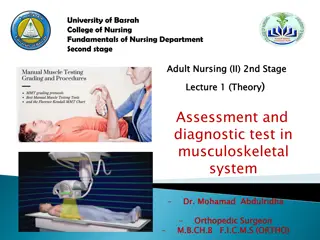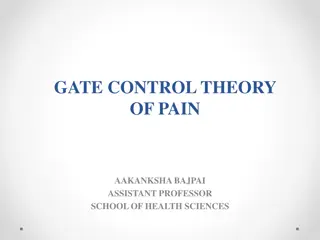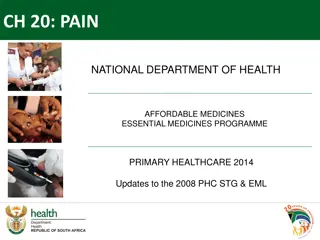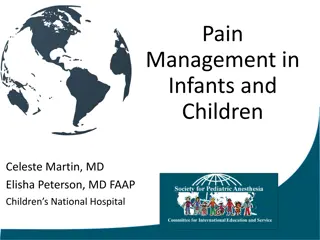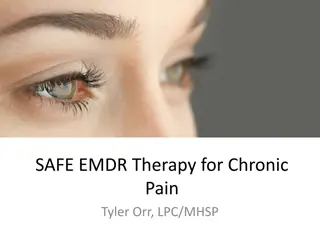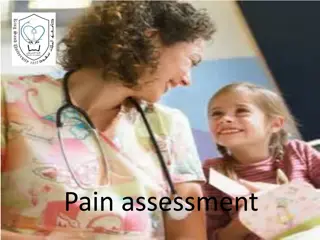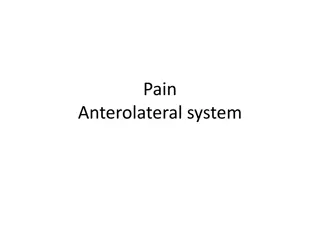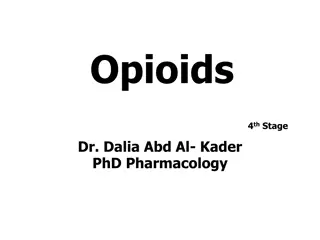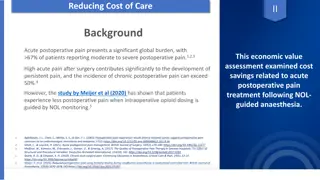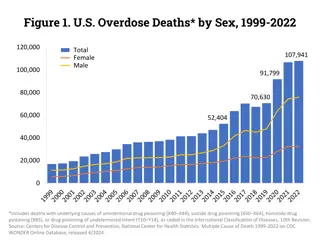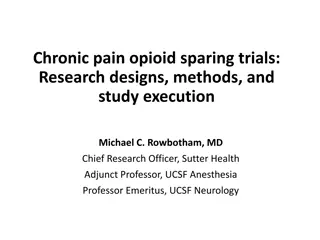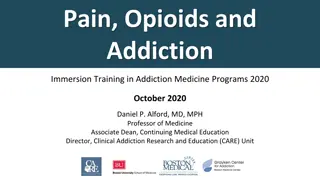Opioids: Pain, Use, and Patient Management
Opioids are commonly used for pain relief, but inappropriate use can lead to dependence and addiction. This presentation explores the impact of opioids in healthcare, the difference between medical and non-medical users, contributing factors to the opioid crisis, and strategies for addressing the challenges associated with opioid use.
Download Presentation

Please find below an Image/Link to download the presentation.
The content on the website is provided AS IS for your information and personal use only. It may not be sold, licensed, or shared on other websites without obtaining consent from the author.If you encounter any issues during the download, it is possible that the publisher has removed the file from their server.
You are allowed to download the files provided on this website for personal or commercial use, subject to the condition that they are used lawfully. All files are the property of their respective owners.
The content on the website is provided AS IS for your information and personal use only. It may not be sold, licensed, or shared on other websites without obtaining consent from the author.
E N D
Presentation Transcript
Opioids Opioids: Pain, Use and Patient Management Dr. Pamela Aaltonen aaltonen@purdue.edu
What Using How Did We Get Here? Prescribing Practices Unintended Consequences Indiana s Plan Good Samaritan Coverage Why Needed Indiana Stats Drug Disposal Harm Reduction Strategies vs. Criminal Approach Legal Action Against Opioid Manufacturers Illegal Opioid Marketplace (use of USPS) Extra Data Where Going?
What are we using in healthcare Natural (from opium/poppy flower) Morphine Codeine Semi-Synthetic (chemical modification of natural opiates) Oxycodone Hydrocodone Meperidine Hydromorphone HCL Fully Synthetic Fentanyl Methadone Buprenorphine Street names: footballs, pink footballs, yellow footballs, 65 s, Ns juice, dillies, drug street heroin, demmies, pain killer, Oxy 80s, oxycotton, oxycet, hillbilly heroin, percs perks, pain killer, vikes, hydros and pinks
So have Medical vs Non-medical opioid users Medical users: take opioids exactly as prescribed for pain relief with no extra doses for pain relief or pleasurable effect Concern: risk of dependence goes up with amount and length of treatment Non-medical opioid users: illicit, prescription drugs used in manner other than directed by provider (physician, nurse practitioner, physician assistant) Given by or stolen from family or friends Doctor shopping Buy from friends, family members, drug dealers Switch to heroin (may be cheaper, readily available); now increasingly cut with fentanyl Start with heroin
How did we get here contributing factors: Health care system tagged with failing to appreciate & treat pain appropriately 1996 OxyContin [Purdue Pharma] approved as a minimally addictive time-released pain reliever Launch of aggressive public campaign Cultural shift in expectations for both health providers (improve assessment and management of pain) and general public (be pain free) 2001 Joint Commission (accreditation body) issued pain standards (pain = 5th vital sign) 2007 Purdue Pharma pleads guilty to federal criminal charge of misleading regulators, doctors and patients $600 M fines & litigation) 1999 to 2015 prescription rate for opioids triples Alternative therapies not as well reimbursed as opioid prescriptions Efficacy? Timetable? Measuring pain?
Number Opioid Prescriptions per 100 residents in top 10 States, 2016 Overall USA 82.6 Michigan IN 9th highest rate 107 Indiana 109.1 Arkansas 115.9 Louisiana 118 Mississippi 120.3 Oklahoma 127.8 Kentucky 128.4 West Virginia 137.6 Tennessee 142 Alabama 142.9 0 20 40 60 80 100 120 140 160
Prescribing Practices Top-prescribing counties 6 X than low- prescribing counties While # of prescriptions , amount per Rx 2nd opioid prescription doubles risk of opioid use 1 year later 1 in 4 prescription users struggle with addiction Suggests: Inconsistent practice patterns Not differentiating among types of pain Lack of consensus re: appropriate use (CDC data ideal duration for Rx is < 3 days) Potential point of contention between patient and practitioner Need for alternatives Source: CDC, 2017, MMWR, 66(26). Changes in Opioid Prescribing in the United States, 2006-2015
Epidemiology informs us that higher amounts of opioids prescribed In micropolitan areas (10,000-50,000 population) For non-Hispanic whites Among uninsured & those enrolled in Medicaid For those with lower educational attainment Among those with higher rates of unemployment In communities with more dentists and physicians per capita Where prevalence of diagnosed diabetes, arthritis, disability is higher In communities with higher suicide rates Meaning? Missed significance of life expectancy in white males in several states Source: CDC, 2017, MMWR, 66(26). Changes in Opioid Prescribing in the United States, 2006-2015
Prescribers treating pain Balance benefits against serious potential adverse outcomes (addiction, overdose, misuse/abuse, and death) Assess patient situation carefully (types of pain) Be knowledgeable about drugs, actions, drug interactions, limitations of use Be familiar with how to initiate, modify, and discontinue use Know how to counsel patients and caregivers on safe use, including proper storage and disposal Be familiar with & advocate for alternative approaches to treating pain Know when to refer to specialists Identify and use community resources
Recommendations for nurse practitioners approach chronic, nonmalignant pain Perform pain assessment -- determine if opioid therapy indicated Apply risk stratification tools -- risk for adverse outcomes to opioids Obtain informed consent from patient to receive opioid therapy Construct mutually developed treatment agreement urine toxicology screening opioid taper plan naloxone rescue education nonpharmacological and behavioral interventions Limit administration & management of opioid therapy to a single primary provider Ongoing evaluation of response to opioid therapy (pain, functioning, adherence) Involve addiction specialist if at risk for substance abuse disorders Abuse-deterrent opioid formulations (difficult to extract active opioid component)
Unintended Consequence of Crackdown on Prescribing Practices Crackdown Decrease in doctor-shopping Restrictions in amounts and timetable of prescriptions Increase in pharmacy robberies (DEA statistics) Between 2009 and 2016, Indiana = 651 robberies (second highest, California with 597 6 X the population of Indiana) Indianapolis drug dealers recruiting juveniles to rob pharmacies Pharmacy Actions Time-release safes (wait to get drugs) Armed guards Height markers Prohibition of hats, sunglasses, hoods at counters Eye-level cameras
Indianas Integrated Response Plan, 2017 Best Practice Indiana Response Dispensing data must be submitted to Prescription Drug Monitoring Program (PDMP) within 24 hours Prescribers not required to consult PDMP Program allows public health to track trend Needs to be integrated with EHR Improving opioid prescribing practices (INSPECT) Expanding use and distribution of naloxone Bills passed to broaden access Expanding [medication-assisted] treatment to reduce opioid use disorders and overdose Elimination of approval for methadone tx for Medicaid recipients Use of telemedicine (Project ECHO) ER/ED referral to treatment access to buprenorphine Environmental Prevention Expansion Increase education through use of social media platforms, etc.
Good Samaritan Overdose Prevention Laws Laws in all states but AZ, IA, ID, KS, MO, ME, OK, SC, TX, WY Naloxone (brand name: Narcan) can reverse opioid overdose Injectable (been in use for 40+ years by emergency response personnel) Auto-injector (EVZIO) thru clothing if necessary Nasal spray (Narcan Nasal Spray) Would one recognize an opioid emergency? Extreme sleepiness/unresponsiveness; unable to awaken Small or pinpoint pupils Slow heartbeat (average 60-100/min, adult) Breathing slow or shallow to not breathing at all (average 12-18/min, adult) Fingernails or lips turning blue/purple
A bit more about Naloxone Antidote binds to opioid receptors in brain preventing drugs from doing its work; temporarily reversing overdose within 2-5 minutes post administration If give to someone NOT overdosing, will have no effect Immunity for calling 911 (good faith reporting) Indiana school districts allowed to stock naloxone as an emergency medicine (like albuterol for asthma and EpiPens for allergies) Bartholomew Schools saved a life (nonstudent) Starting in 2017 must report to State when drug used on school property Cost ~ $37.50 per dose (18 month shelf live); going up
Naloxone access via Pharmacy Chains Nacan Nasal Spray without prescription available at Walgreens other than North Dakota (no Walgreens), Puerto Rico and US Virgin Islands by end of 2017 (previously 33 states) CVS currently offers prescription-free naloxone in 43 states Demo devices in pharmacies Education when individual dispensed drug which places at risk for accidental overdose Cost may be an increasing factor; as demand increases, costs up One fire department $6 in 2010; $30 in 2016 Evzio (auto-injector $288 in 2014; $2,000 in 2017; up to $4,500 in some markets) Talking device
Non-Fatal Hospitalizations Due to Opioid Overdose, Indiana 2015 County # County # County # County # Adams 5 Hamilton 27 Lawrence 7 Sullivan 5 Allen 99 Hancock 10 Madison 48 Tippecanoe 32 Bartholomew 11 Hendricks 17 Marion 224 Vanderburgh 59 Boone 12 Henry 12 Marshall 14 Vermillion 14 Clark 13 Howard 21 Monroe 15 Vigo 26 Clinton 10 Huntington 14 Montgomery 9 Wabash 10 Counties not on list had < 5; data suppressed Dearborn 16 Jackson 6 Morgan 18 Warrick 8 Decatur 5 Jasper 9 Noble 8 Washington 5 DeKalb 5 Jefferson 6 Owen 6 Wayne 39 Delaware 54 Jennings 5 Porter 53 Wells 8 Dubois 5 Johnson 22 Randolph 9 White 5 Elkhart 36 Knox 9 St. Joseph 81 Whitney 8 Fayette 10 Kosciusko 15 Shelby 9 IN Total 1430 Floyd 17 Lake 94 Starke 7 Source: ISDH Epidemiology Report 2016, Table 7 Grant 12 LaPorte 30 Steuben 8
Database of public drug disposal locations Medication disposal program also key Prescription drugs, including opioids Over-the-counter medications Not accepted Illegal drugs, needles, lotions or liquids, inhalers, thermometers, hydrogen peroxide, aerosol cans
Harm Reduction Strategies vs. Criminal Approach best strategies? Philosophy: not endorse drug use, but accepts drug use as a reality and focuses on reducing harmful consequences (death, HIV, Hepatitis C, dysfunction, criminal activity, incarceration) Harm reduction strategies Syringe exchange Possession of syringes is not illegal under federal law Bloodborne disease transmission Opioid agonist therapy Methadone: treatment clinics Buprenorphine: prescribed and dispensed since 2002 in physician offices Challenges: access to clinics, insurance coverage, access if incarcerated Overdose prevention Federal funds may be used to purchase & distribute naloxone (Comprehensive Addiction and Recovery Act, 2016) Supervised consumption sites (Europe, Canada, Australia) Seattle, WA pilot consumption sites Heroin-assisted treatment (some European countries and Canada) Law-Enforcement Assisted Diversion Diverted from criminal system to community-based support services Seattle, Santa Fe, Atlanta, Louisville, Fayetteville, etc. Cannabis as substitute drug Needs more research; marijuana surprisingly minimally researched
Legal Action Against Opioid Manufactures 2015 West Virginia, New Hampshire, and Kentucky civil lawsuit against Purdue Pharma 2017 (November) Indiana cities join many cities across country Indianapolis Hammond Basis Racketeering, negligence deceptive marketing practices to promote use beyond effective short-term use Failure to identify, report, and stop suspicious orders of medications
Illegal Market for opioids (coming in from black market) Senate Government Oversight and Homeland Security Committee meeting now with focus on Preventing Drug Trafficking through International Mail Internet Pharmacy and Health Product Sector USPS carrier of choice for illegal online pharmacies In one study, 29/29 test purchases reached intended destination Illicit drugs website, Silk Road,the dark net initiated in 2011 Why? USPS paper tracking system is challenging Customs and Border Protection; 2,000 officers short of full enforcement capacity so minimal inspections UPS and other private carriers typically have sophisticated tracking systems so know what carrying
Resources US Department of Justice, Drug Enforcement Administration (2017). Drugs of Abuse. Available at: https://www.dea.gov/pr/multimedia- library/publications/drug_of_abuse.pdf Indiana s Integrated Response to the Opioid Epidemic, 2017, https://in.gov/recovery/files/2017%20Indiana%20Integrated%20Response%20Opio id%20PNF.PDF Quinones, S. (2015). Dreamland: The True Tail of America s Opiate Epidemic (focus West Virginia, Ohio, and Indiana) Christie, C. (President s Commission) Draft Report, 2017 https://www.whitehouse.gov/sites/whitehouse.gov/files/ondcp/commission- interim-report.pdf
Extra Slides Death (mortality) statistics Heroin
2016, Persons Receiving Substance Abuse Treatment 23% using prescription opioids at time of admission 36% using heroin or prescription opioids (or both)
US Mortality Trend Lines
Indiana Mortality Data Overdose death rate in 2013 16.6 per 100,000 population, above national rate of 13.8
2015 US Drug Overdose Deaths Synthetic Opioids/Heroin/ Methadone Rate per 100,000 population Minus Heroin and Methadone Rate per 100,000 population Synthetic Opioids/Heroin/ Methadone Rate per 100,000 population Minus Heroin and Methadone Rate per 100,000 population Overall 3.9 3.1 Race/Ethnicity Gender White 5.3 4.2 Male 4.8 4.2 Black 2.1 2.1 Female 3.0 1.9 Hispanic 1.5 0.9 Age Region 15-24 1.6 2.3 Northeast 3.6 5.6 25-34 5.3 6.6 Midwest 3.4 3.9 35-44 6.9 5.6 South 4.4 2.8 45-54 8.1 4.6 West 3.8 0.9 55-64 6.4 2.9 Synthetic = oxycodone, hydrocodone, fentanyl > 65 1.5 0.5 Source: CDC, 12/30/16, MMWR, 65(50-51)
Indiana Drug Overdose Deaths Deaths Total Drug Overdoses (includes cocaine, stimulants, unspecified, etc.) 203 609 923 1236 Opioid Pain Relievers Year Heroin 2000 2005 2010 2015 < 5 13 54 239 24 118 229 274 Source: ISDH Epidemiology Resource Center, Table 2, 2016
Sources of Heroin Afghanistan (63-75% globally) Mexico (most of US market) China (fentanyl) But marketplace is the USA $70 B annual industry (~ 32.4 M users globally) Historical note: sold commercially by Bayer from 1898-1913 (focus on weaning soldiers off of morphine) Common cutting agents also include powdered sugar, baking soda, starch, talcum powder, laundry detergent, powdered milk, rat poison Cheaper often than cigarettes
